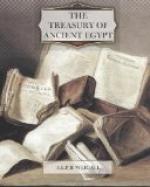The resident in Egypt, interested in archaeology, comes to look with a kind of horror upon museums, and to feel extraordinary hostility to what may be called the museum spirit. He sees with his own eyes the half-destroyed tombs, which to the museum curator are things far off and not visualised. While the curator is blandly saying to his visitor: “See, I will now show you a beautiful fragment of sculpture from a distant and little-known Theban tomb,” the white resident in Egypt, with black murder in his heart, is saying: “See, I will show you a beautiful tomb of which the best part of one wall is utterly destroyed that a fragment might be hacked out for a distant and little-known European museum.”
To a resident in Europe, Egypt seems to be a strange and barbaric land, far, far away beyond the hills and seas; and her monuments are thought to be at the mercy of wild Bedwin Arabs. In the less recent travel books there is not a published drawing of a temple in the Nile valley but has its complement of Arab figures grouped in picturesque attitudes. Here a fire is being lit at the base of a column, and the black smoke curls upwards to destroy the paintings thereon; here a group of children sport upon the lap of a colossal statue; and here an Arab tethers his camel at the steps of the high altar. It is felt, thus, that the objects exhibited in European museums have been rescued from Egypt and recovered from a distant land. This is not so. They have been snatched from Egypt and lost to the country of their origin.
He who is well acquainted with Egypt knows that hundreds of watchmen, and a small army of inspectors, engineers, draughtsmen, surveyors, and other officials now guard these monuments, that strong iron gates bar the doorways against unauthorised visitors, that hourly patrols pass from monument to monument, and that any damage done is punished by long terms of imprisonment; he knows that the Egyptian Government spends hundreds of thousands of pounds upon safeguarding the ancient remains; he is aware that the organisation of the Department of Antiquities is an extremely important branch of the Ministry of Public Works. He has seen the temples swept and garnished, the tombs lit with electric light, and the sanctuaries carefully rebuilt. He has spun out to the Pyramids in the electric tram or in a taxi-cab; has strolled in evening dress and opera hat through the halls of Karnak, after dinner at the hotel; and has rung up the Theban Necropolis on the telephone.
A few seasons’ residence in Egypt shifts the point of view in a startling manner. No longer is the country either distant or insecure; and, realising this, the student becomes more balanced, and he sees both sides of the question with equal clearness. The archaeologist may complain that it is too expensive a matter to come to Egypt. But why, then, are not the expenses of such a journey met by the various museums? A hundred pounds will pay for a student’s winter in Egypt and his journey to and from that country. Such a sum is given readily enough for the purchase of an antiquity; but surely rightly-minded students are a better investment than wrongly-acquired antiquities.




